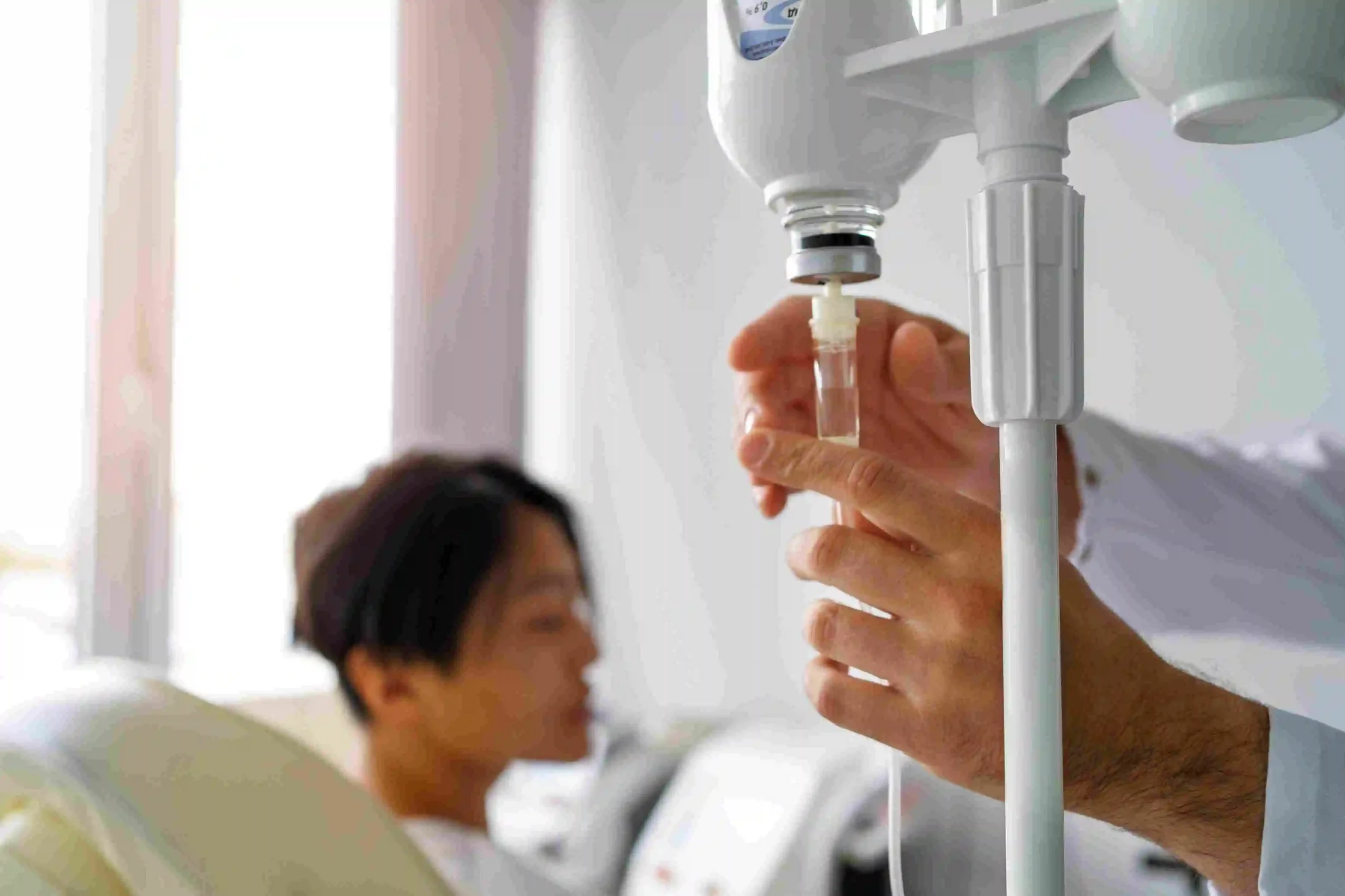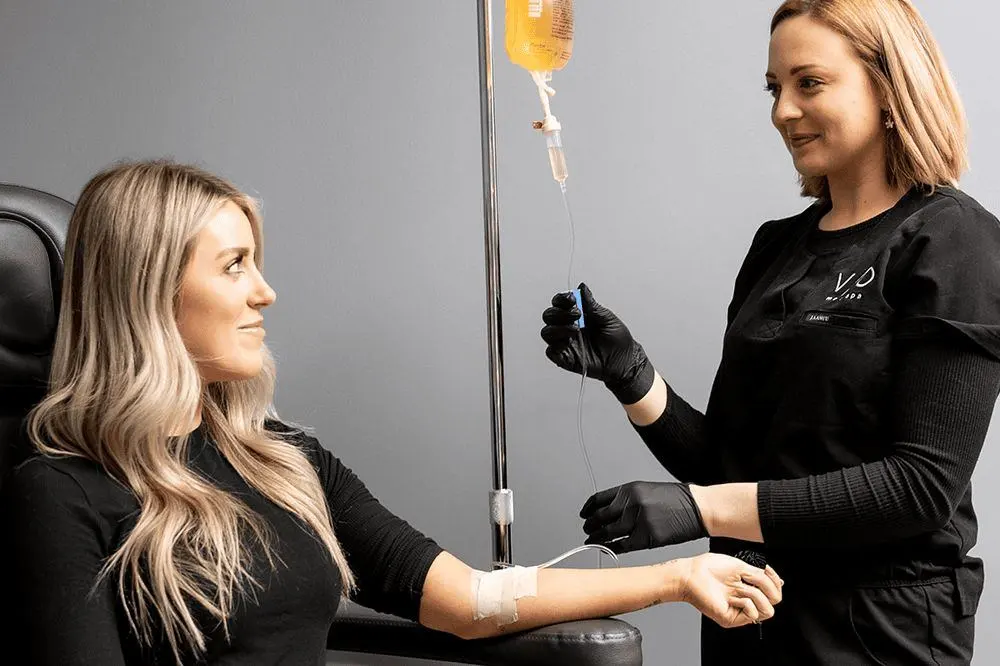Your Health, Our Priority - Experience the Benefits of
IV Drip Therapy in Riyadh
Replenish, Recharge, Revive With Us!
Read in Arabic
What is an IV?
The abbreviation IV stands for intravenous infusion or intravenous therapy. It is a medical procedure that includes injecting substances directly into a patient’s vein, including fluids, medicines, and nutrition. A solution is administered into the patient’s circulation by an IV catheter, a small, flexible tube that is placed into a vein in the arm, hand, or another area of the body.
Intravenous therapy is used for a number of purposes, including hydration, pharmaceutical administration, the delivery of blood components or chemotherapy, and more. An IV is a speedy and efficient way to administer fluids and medications since they are quickly absorbed by the body.
Procedure Time
45 - 60 Mins
Downtime
10 - 15 Mins
Back to Work
Immediate
Results
1 - 4 Hours
What is IV fluid made of?
Water, electrolytes, and other additions like drugs, vitamins, or minerals are all included in IV fluids. The precise make-up of IV fluid varies based on the therapy’s goal, the patient’s health, and other elements.
Electrolytes, including sodium, potassium, chloride, and bicarbonate, are crucial elements of intravenous fluids because they support the body’s appropriate fluid and electrolyte balance. Aside from these, IV fluids frequently contain vitamins, amino acids, and dextrose, a type of sugar.
Types of IV fluids
The patient’s medical state, fluid and electrolyte balance, and other considerations all play a role in the choice of IV fluid, which comes in a variety of varieties. The following are some typical IV fluids
Normal Saline
The most popular IV fluid is normal saline (0.9% sodium chloride), an isotonic solution with the same ratio of salt to water as bodily fluids. Dehydration, vomiting, and diarrhea can all be treated with it.
Lactated Ringer's Solution
Lactated Ringer’s solution is a frequent treatment for dehydration, fluid resuscitation, and restoring electrolytes lost during surgery. It contains electrolytes like sodium, potassium, and calcium.
Dextrose Solution
This fluid, which is made up of water and sugar (dextrose), is used to treat hypoglycemia (low blood sugar) or to give patients who are unable to ingest calories.
Hypertonic Saline
In order to cure hyponatremia, hypertonic saline, a solution with a greater salt concentration than regular saline, is utilized (low sodium levels in the blood).
Plasma Volume Expanders
In situations of shock or significant blood loss, plasma volume expanders are used to raise blood volume. Albumin, dextran, and hydroxyethyl starch are a few examples.
Parenteral Nutrition Solutions
Parenteral nutrition solutions are used to feed patients who are unable to eat or absorb nutrients through their gastrointestinal tract. They contain amino acids, vitamins, and other nutrients.
It is essential to remember that the choice of IV fluid relies on the patient’s health and should only be made by a qualified medical expert.
What is a Hydration IV Drip?
- A type of intravenous (IV) therapy known as a hydration IV drip allows patients to get fluids straight into their bloodstream, which aids in rehydrating the body. The typical composition of the solution is water, electrolytes, and occasionally other supplements like vitamins or minerals.
- Hydration Dehydration can be treated with IV drips for a variety of causes, including vomiting, diarrhea, excessive perspiring, or not consuming enough fluids. A rapid hydration and electrolyte balance are made possible by the speedy absorption of fluids given via an IV.
- Other uses for hydration IV infusions include boosting energy levels, enhancing immunological function, and promoting general wellness. According to some clinics or spas, hydration IV drips can help with hangover symptoms because they contain electrolytes and water.
- It is important to remember that hydration IV drips should only be delivered by licensed medical personnel because IV therapy carries some dangers, including infection and fluid excess. Moreover, water consumption and healthy lifestyle practices that promote optimal hydration should not be substituted for hydration IV drips.
What is an IV Drip used for?
An intravenous (IV) drip is a medical tool used to deliver fluids, drugs, and nutrients straight into a patient’s bloodstream. There are several medical uses for IV drips, including:
- Rehydration: Dehydration brought on by vomiting, diarrhea, excessive perspiration, or not drinking enough fluids can be treated with IV fluids.
- Drug administration: An IV can be used to administer many medications, including antibiotics and painkillers, for a faster and more efficient course of therapy.
- Delivery of nutrients: Patients who are unable to consume or absorb nutrients through their gastrointestinal tract might receive vital nutrients, such as amino acids, vitamins, or minerals, through IV infusions.
- Blood transfusions: Patients who require a transfusion might receive blood or blood components through IV drips.
- Chemotherapy: To specifically target cancer cells, chemotherapy medications are frequently administered through an IV drip during cancer treatments.
- Anesthesia: Patients having surgery or other medical procedures can receive anesthesia medications via IV drips.
Hydrate, Detox, & Recover with a Home IV Drip Appointment at Enfield Royal Clinic Saudia!
How does Drip IV Therapy and hydration work?
- Via the use of an intravenous (IV) catheter, drip IV therapy and hydration transfer fluids, electrolytes, and occasionally other nutrients directly into a patient’s bloodstream. Typically, sterile, isotonic solutions that closely resemble the body’s natural electrolytes and fluids are utilized in IV therapy.
- A rapid hydration and electrolyte balance are made possible by the speedy absorption of fluids given via an IV. This is especially helpful in cases of electrolyte imbalances or dehydration, which can happen for a number of causes, including vomiting, diarrhea, excessive perspiration, or not drinking enough water.
- IV therapy can be used to administer drugs or other nutrients directly into the bloodstream in addition to replacing lost fluid and electrolytes for a quicker and more efficient course of treatment. To treat a variety of medical diseases, IV treatment can be used to administer antibiotics, analgesics, or vitamins.
- A skilled medical expert will place an IV catheter into a vein during IV therapy, typically in the arm or hand. The catheter is then joined to a bag containing fluid and any additional elements, such as nourishment or medication, that are required. Depending on the patient’s health, the fluid can be injected into the patient’s bloodstream at a controlled rate through the catheter.
- It is important to remember that in order to reduce the danger of infection or other consequences, IV therapy should only be delivered by licensed medical professionals. Also, even while IV therapy can be an effective tool in the treatment of some medical disorders, it should not be used as a replacement for living a healthy lifestyle and staying well hydrated.
Benefits of IV Drip
Receiving an IV (intravenous) drip may have a number of advantages, including:
- Rehydration: In cases of dehydration, such as those following strenuous activity or illness, IV infusions can swiftly and effectively refill fluids and electrolytes.
- Delivery of medication: IV therapy has the ability to deliver medication straight to the bloodstream, offering quick and efficient relief for ailments like infections, nausea, and pain.
- Delivery of nutrients: For those who have trouble absorbing nutrients through their digestive system, IV drips can offer a speedy and effective means to give vital vitamins, minerals, and nutrients to the body.
- Treatment in an emergency: IV drips can swiftly and effectively administer life-saving medications in cases like severe bleeding or poisoning.
- Cancer treatment: IV therapy, which can be more efficient than oral medication, is frequently used to administer chemotherapy chemicals directly into the bloodstream.
- Increased sports performance: After strenuous exercise or competition, some athletes utilize IV drips to swiftly restore fluids and electrolytes, which can enhance performance and speed up recovery.
What Are the Side Effects of IV Drip?
A tube is put into the arm or hand to deliver fluids, medications, or nutrients directly into a patient’s veins during intravenous therapy, or IV drip. Despite the fact that IV drips are generally safe, some negative effects are possible.
- Infection is one of the most frequent IV treatment side effects. An infection may occur if the site of insertion or the needle or catheter used to administer the drip are not properly sanitized or cleansed.
- Phlebitis is an inflammation of the vein that can result in discomfort during injections as well as redness and swelling.
- Fluid overload: When too much fluid is given too rapidly, it can lead to symptoms like edema, elevated blood pressure, and shortness of breath.
- Certain IV fluids can change the body’s electrolyte balance, which can lead to cramping in the muscles, weakness, and irregular heartbeats.
- Reactions to drugs or fluids given through an IV drip in certain persons may cause an allergic reaction. Hives, itching, and breathing difficulties might be signs of an allergic reaction.
How Long Does an IV Drip Take?
- The type of solution being supplied, the reason for the IV, and the demands of the specific patient are just a few of the variables that affect how long an IV drip will last. The majority of IV drips can be finished anytime between 30 minutes and many hours.
- A straightforward IV drip that supplies a simple combination of water and electrolytes, for instance, might only take 30 to 60 minutes to complete. Yet, the infusion process for an IV drip carrying medicines or more complicated solutions could take many hours.
- Depending on the patient’s requirements and condition, the IV drip’s rate can also be changed. For drugs that need to be administered more gradually, a slower rate of infusion may be appropriate, but a quicker rate may be required in cases of severe dehydration or electrolyte imbalances.
- It is crucial to remember that the length of IV therapy is decided by the medical professional depending on the requirements and health of each patient. Regarding the length and frequency of IV therapy, patients should always abide by the recommendations of their doctor or other healthcare professional
How to Do IV Drip?
Only trained medical experts should administer an IV drip since it requires specific knowledge. Nonetheless, the fundamental procedures for giving an IV drip are as follows:
- Prepare the tools: Gather all the equipment that is required, such as the fluid bag, IV catheter, and tubing. Verify that everything is clean and functioning properly.
- Get the patient ready: Get the patient’s informed permission after describing the process to them. Choose a suitable vein to place the catheter into before cleaning the area with an antiseptic solution.
- Insert the catheter: Put the catheter into the patient’s vein using sterile procedures. Make that the catheter is positioned correctly and that no blood is dripping from the site of insertion.
- After positioning the catheter, attach the tubing to it, making sure there are no air bubbles in the line in the process.
- Change the flow rate: Configure the IV drip’s flow rate in accordance with the doctor’s instructions. Keep an eye on the patient’s health and change the flow rate as necessary.
- Monitor the patient: Throughout the IV therapy session, keep an eye on the patient’s vital signs and overall health. Keep an eye out for any indications of problems, such swelling or redness at the insertion site.
- Remove the catheter: Once IV therapy has been administered, carefully remove the catheter from the patient’s vein. To halt any bleeding, apply pressure to the insertion site.
What is the Cost of an IV Drip in Riyadh?
IV Drip
Starting FromIV Drip
StandardIn Riyadh, Saudi Arabia, the price of an IV (intravenous) drip can change depending on a number of variables, such as the kind of fluid or medication being given, the length of the treatment, and the facility where the treatment is being given.
In single session the Cost of IV drip in Riyadh typically ranges from 100 and 500 SAR, though some treatments may be more expensive depending on the patient’s individual needs. But, depending on these and other circumstances, the real cost may differ significantly.
Why Choose Us?
It is very important to go for the right doctor in order to get yourself the best treatment. At Enfield Royal Saudi, you will find the best doctors who provide best service and satisfy their patients with their work.
Best Doctor in Riyadh
The top medical professionals may be found at Enfield Royal Saudi. We want to ensure that all of our patients are completely satisfied, so we only employ the greatest medical professionals with extensive training and expertise. We provide the greatest customer service in the area and work closely with our patients in every aspect.
Cheap Clinic in Riyadh
In Riyadh, Enfield Royal Saudia is not only the best clinic, but also the most affordable. with respect to other clinics. You can receive treatment on a budget because of the adaptability and affordability of our prices.
FAQs.
A slight irritation or pinching sensation may be felt when inserting an IV catheter for an IV drip, but it should not hurt. After the needle is put into the vein, the majority of people say they only feel a minor pressure or pain. The experience may, however, affect some people more than others.
There should not be any pain experienced by patients once the IV drip is started. Yet, depending on the temperature of the solution, people can experience warmth or cooling as the fluid enters the bloodstream.
It may hurt or be uncomfortable if the IV catheter is placed incorrectly or gets loose. Moreover, some people may react to the fluid being infused, such as by developing an allergy or developing a rash where the fluid is being infused.
In order for the medical professional delivering the IV drip to address any concerns and guarantee the patient’s comfort throughout the operation, it is crucial to report any discomfort or pain.
Some medical conditions or circumstances may benefit from receiving an IV (intravenous) drip. When someone is dehydrated, IV therapy can help them rehydrate by replacing fluids and electrolytes, as well as providing emergency therapies like blood transfusions or antidotes for poisoning.
In order to quickly and effectively administer medication or nutrients directly into the bloodstream, IV drips are frequently utilized in hospitals and other healthcare facilities. Also, they can be utilized for chemotherapy and other protracted medical procedures that call for repeated pharmaceutical delivery.
An IV drip is not always required or suitable for everyone, though. Given the potential hazards and adverse effects of the treatment, it should only be carried out under the supervision of a medical practitioner. The choice to employ IV therapy will be based on the patient’s individual medical requirements and condition.
The purpose of an IV drip and the patient’s unique medical condition will determine how frequently the person should receive one.
The restoration of fluid and electrolyte balance, for instance, may only require one IV drip session in cases of dehydration or electrolyte imbalance. Yet, if a patient is getting chemotherapy by IV therapy, they might require regular IV drips over the course of several weeks or months.
IV treatment is often only advised in cases when it is medically required and should be done by a qualified healthcare provider. Based on the patient’s unique requirements and condition, the healthcare provider will choose how frequently to administer IV therapy.
While IV therapy may be helpful for some medical disorders, it should be noted that it is not a replacement for a healthy lifestyle or appropriate medical care. Speak with your healthcare practitioner if you have questions regarding the frequency of IV therapy or if it is appropriate for you.
Side effects are rare but can occur. Some individuals may experience mild discomfort at the injection site, bruising, or allergic reactions to specific ingredients.
IV drip therapy should not replace a healthy diet or necessary oral supplements. It is intended to complement a well-rounded lifestyle and provide a quick infusion of nutrients for specific purposes.
Relevant Treatments.

Vitamin drip Riyadh
Say goodbye to fatigue and welcome to a radiant, revitalized you on one drip at a time! We offer you the best and most effective Vitamin drip in Riyadh. Our drips infuse your system with important nutrients and revive vitamins that deliver powerful energy to your body. Read the below page for additional information.

IV Drip at Home in Riyadh
It is a secure therapy that guarantees optimum absorption of important minerals, nutrients, and amino acids. IV Drip at Home in Riyadh is the answer you need if you’re struggling with sensations of weakness, dehydration, and weariness but would want to stay away from clinic visits.
Relevant Posts.

IV Drip Cost
Step into a world of revitalization and renewed energy, where every drop counts towards your well-being. For those seeking a rejuvenating boost that goes beyond the ordinary, welcome to a realm where..

